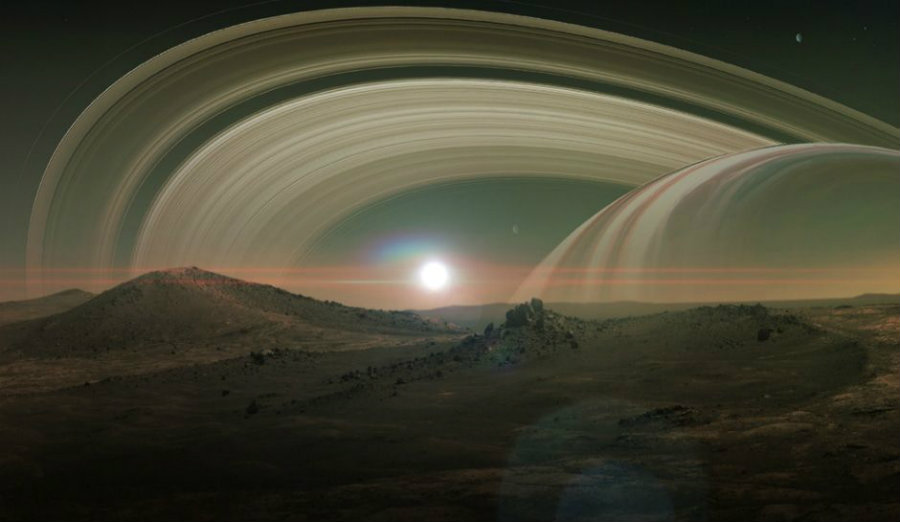Scientists discovered that Saturn’s moon, Titan, has some molecules that could be essential to the development of life, though a very different type of life.
Titan’s thick atmosphere holds significant quantities of vinyl cyanide molecules that might be useful to form membranes around cells that are found in the seas of that moon. Scientists consider that the seas of Titan can be good enough for creatures to inhabit.

“It’s definitely a rough estimate because there are just so many things we don’t know about Titan,” study lead author Maureen Palmer, of NASA’s Goddard Space Flight Center in Greenbelt, Maryland, told Space.com.
Titan seems like the best place to find life in the solar system
Titan is an incredibly big moon that goes around Saturn. After the latest research, scientists think that Titan could be an ideal location to find other ways of life in the solar system. The moon has a thick atmosphere, predominantly made up of nitrogen and other compounds that are commonly associated with life on Earth.
In Earth, the membrane, which is the outer layer of cells, is created with fatty molecules named lipids. In Titan, there is no possibility for lipids to exist, since they require water – in a liquid state – to be formed; and in this moon, the temperatures are about -290 degrees Fahrenheit on the surface.
The good news is that Titan has lakes of liquid methane, and astronomers think that they might offer the conditions for other forms of life. In fact, they found Titan is full of vinyl cyanide molecules that could be perfect for the development of life.
“This is a far cry from saying [life] definitely happens on Titan and these cells are involved in some kind of primitive life,” co-author Martin Cordiner, an astrochemist at NASA’s Goddard Space Flight Center, “But it gives us a starting point in that discussion. If there was going to be life in Titan’s oceans, then it’s plausible vinyl cyanide could be a component of that.”
They detected the presence of the vinyl cyanide by measuring the radio waves of Titan
This incredible discovery was made by ALMA, one of the most sensitive telescopes in the world. It was created in the Atacama Desert of Chile with the collaboration of several universities, observatories, and scientists from all over the world. ALMA is made up with 66 different individual telescopes.
In Titan, the gas molecules are in constant movement, going from one place to another and changing their energy-levels non-stop. However, when a gas molecule goes from a high-energy level to a lower one, it releases a radio wave, changing its frequencies. ALMA was able to find how many waves were being emitted by Titan at a determinate frequency. That is how it calculated how much vinyl cyanide existed in Saturn’s moon.

This lets scientists know about the presence of vinyl cyanide in the atmosphere; however, it could also be present in the lakes below. If methane goes to a weather cycle similar to the one on Earth, then it is possible because that means that the vinyl cyanide would fall to the surface as rainfall from time to time, and this would let it form cell membranes deep in the lake.
The idea of life on Titan is still uncertain. However, ALMA’s findings are essential to continue this research, and it had increased the interest of earthlings in Titan.
There could be 10 million cell membranes per cubic centimeter in one of Titan’s lakes
If these hypotheses are certain, then – based on the data collected by ALMA – about 0 million cell membranes per cubic centimeter could exist in just one of Titan’s lakes, Ligeia Mare, which is the largest lake of the moon.
These cell membranes could be pretty flexible, according to Paulette Clancy, a professor of chemical and biomolecular engineering at Cornell University. Clancy says that this flexibility could be essential for the cells to divide and reproduce. They could work just as the cell membranes on Earth, even though their chemical composition is entirely different.
The only way to know for sure that vinyl cyanide created membranes in Titan, is to send a probe to the moon to seek what is inside of the lake.
“There’s been some discussion of maybe sending a boat or something like that to Titan to observe what’s really going on in the lakes,” says co-author Maureen Palmer, an astrochemist at NASA’s Goddard Space Flight Center. “That’d be really cool to see.”
Vynil Cyanide is a complex molecule that is made up of seven elements. It is not known how such a complex molecule is present in a place that is so far away from Earth, but it is proof that there are things about the planet’s moons that scientists still have to find out.
Source: The Verge

Bullshit. Simple.